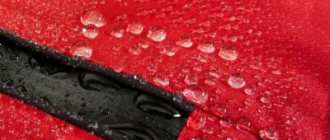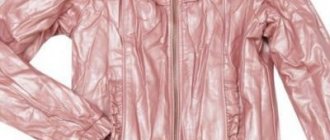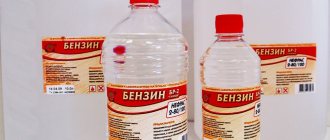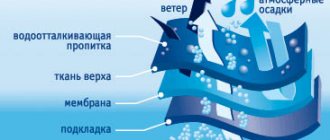Modern clothing and footwear made using special membrane material are becoming more and more accessible to a wide range of buyers.
If initially the membrane was used to create specialized lightweight, windproof and waterproof clothing for winter sports, today it is used to make everyday jackets and comfortable clothing for children and adults.
Features of the material
Membrane fabric is a breathable material made of synthetic fiber, which is characterized by a large number of tiny holes and is characterized by:
- Waterproof. The higher the number of this indicator, the better the membrane material resists moisture penetration. A coefficient of 10,000 indicates that the fabric will not get wet in heavy rain.
- Vapor permeability. The structure of the synthetic fabric is such that it allows steam to escape, removing excess heat and moisture from the body. This provides comfort during high physical activity in cold weather. The higher the vapor permeability index, the better the quality of the material.
- Windproof. The membrane reliably protects from wind.
The clothes use two-layer and three-layer membrane fabrics. The outer layer consists of ordinary matter, the inner layer is made of membrane fabric. There may also be a bottom layer of knitted mesh.
The membrane itself is not insulation; it creates comfort provided that a person moves intensively, generating heat. Therefore, a winter envelope for a newborn, clothes for a sedentary child, in addition to the membrane, must contain vapor-permeable synthetic insulation.
How can you wash the membrane?
For high-quality and effective washing, it is recommended to use special liquid detergents. Stores that sell equipment and workwear made from membrane fabrics always have the appropriate products. They are usually offered at the checkout, and they immediately select the option for your membrane. The best option not to make a mistake is to buy everything you need at once.
- Membrane cleaners are mostly universal, but still read the label carefully before purchasing. Among the recommended manufacturers it is worth mentioning: Nikwax, Grangers, Holmenkol, Collonil.
- Impregnations are more picky; the choice depends on the material, insulation and other details. Some impregnations are initially intended only for backpacks or only for awnings, but not for clothing. If in doubt, ask a consultant for help.
Do not use conditioners, stain removers, antistatic agents or other additional products under any circumstances. Even if your favorite jacket has an unpleasant stain, there is no need to pour bleach on it. This way you will only damage the structure of the membrane; it will no longer be possible to restore it.
Washing rules
In order not to spoil the high-tech material, you need to know how to care for membrane clothing. Synthetic fabric has a porous structure, and these tiny pores become clogged with sweat and dirt over time. A child's walks often result in dirty clothes, despite the applied impregnation with water- and dirt-repellent properties.
A contaminated membrane has reduced vapor permeability, so regular washing is necessary. But at the same time, membrane items should be washed as rarely as possible - any impact reduces the strength of the fibers and the functional properties of the material are lost over time.
To properly wash membrane clothing, follow these principles:
- Do not use fabric cleaning or bleaching products, primarily those based on chlorine - it destroys the membrane and the fabric will become wet;
- It is forbidden to wash with ordinary washing powder and liquid detergents, including those for delicate washing - they can clog the smallest pores, causing the material to stop releasing steam;
- washing items is allowed only at the temperature indicated on the product label (30-40 degrees depending on the type of material) - heating harms the structure of the fabric, for the same reason it is forbidden to boil or iron the product;
- For washing, it is allowed to use only special products marked “for sportswear” or “for membrane fabrics.”
When purchasing this type of clothing, it is recommended to immediately purchase a detergent for washing membrane fabrics - its price is quite high, but due to the economical consumption, the cost of one wash is low.
If you don’t have special equipment at hand, and you need to wash the membrane jacket urgently, you can use simple laundry soap. In this case, the item is not soaped, but dipped in warm soapy water. It is important to rinse the clothes several times and next time be sure to use a special product to remove any remaining soap from the membrane pores.
It is recommended to wash membrane clothes by hand. If the label says machine washable, select the delicate cycle.
When washing in a washing machine, be sure to program the lowest speed for rinsing and completely disable the spin option - rotating the item in the drum even at relatively low speeds leads to water mechanically damaging the structure of the porous material.
If the manufacturer has not indicated the possibility of machine washing, do not experiment - there is a high risk of material delamination, membrane destruction, deformation and damage to fasteners.
Note! To keep your jacket clean and wash it as little as possible, scrub dirty areas with clean warm water using a fluffy brush or foam sponge.
Properties
The membrane has hydrophilic and hydrophobic components. It sounds complicated, but it's actually simple.
Hydrophilic means attracting water and managing moisture. That is, the fabric absorbs sweat and releases it outside, where evaporation occurs. In other words, it breathes, hence the term airtightness.
Hydrophobic property is when the membrane prevents water, such as rain from outside, from entering the jacket. Heat is retained inside and moisture comes out.
Ski overalls and jackets are made from this fabric.
The advantages of membrane clothing are that it is convenient to move around in it, it is light and comfortable, and you do not need to wear a ton of clothes. In addition, such things are easy to wash.
Hand wash technology
Let's look at how to wash a jacket with a membrane. When using special products, washing items without pre-soaking is allowed. But if the product is heavily soiled, it is dipped into a basin with a dissolved product and left for one and a half to two hours.
In order not to damage the product, when washing by hand, you should not rub items of clothing against each other, squeeze out the material, strongly deform it, or “collapse” inflated bubbles from waterproof fabric.
The most contaminated areas on the outside of the jacket (primarily the collar, cuffs) can be gently rubbed with a foam sponge or fluffy brush dipped in the water in which the clothes are washed.
To rinse the item, place it in a bowl of clean, cool water for 15-20 minutes. Then take it out, let the excess water drain, and then immerse it again in a basin with fresh clean, cool water. This time, carefully remember the jacket with your hands. It is recommended to rinse the washed item for the third time in water with a dissolved antistatic agent.
You cannot wring out membrane clothing - just let the excess water drain (you can put the item in a net and hang it over the bathtub). Then the jacket is straightened, all zippers are fastened so that they do not become deformed, and hung on hangers or a dryer.
Dry the product away from direct sunlight and heating devices. Do not dry it in the drum of a washing machine with dryer or in a special unit, use a hair dryer, fan heater or iron. Do not iron the membrane fabric.
In the washing machine
If the fabric your breathable jacket is made from is strong enough and the label states that it can be machine-washed, this can make the process much easier.
Select delicate mode (temperature no higher than 40°C, no spin). Instead of washing powder, use a special detergent. Greasy areas can be pre-moistened with dishwashing liquid.
When washing such items, the machine must not be overloaded: with a large load, the friction of the membrane against other things will increase, which can destroy its unique properties. With intensive spinning at high speeds, due to the strong mechanical impact of the machine drum on the fabric structure, the same thing will happen.
Air conditioning, as you already know, cannot be used either. Remember this or hang a “reminder” near the machine so as not to automatically pour it into the cell.
Rules of care
Caring for membrane clothing includes treating it with a water-repellent agent. A special spray is applied from a can onto the washed and dried item. It is important to choose the right aerosol - it should be intended specifically for membrane clothing. Impregnation allows you to maintain high water-repellent properties of the membrane material.
Follow the storage rules:
- Only washed items are placed in storage;
- there should be no strong-smelling substances nearby (mothballs, etc.);
- the storage place must be dry;
- suits and jackets are stored flattened.
With proper care of things, clothes made from membrane materials will last as long as possible.
Drying
This process also has its own subtleties, which are due to the same fragile properties of the membrane. However, these are the properties that are valuable in it, so you should try to preserve them as much as possible.
Lightly wring out the jacket (do not twist it) and wrap it in a large terry towel, terry sheet or bathrobe to absorb excess moisture.
Now place the item on a table or other horizontal plane and carefully straighten it, smooth out all the creases and folds. Now the jacket needs to be dried. The ideal option is to hang it on clothes hangers above the bathtub: the temperature in the room is not very high, the water has somewhere to drain, and the radiators are far enough away.
Treatment after drying
Washing, rinsing and even drying a membrane jacket is not all. To extend the service life of things, it is necessary to perform one more procedure: impregnation with a special water-repellent composition. Such products are available in the form of liquids or sprays. The older the item, the greater the need for such treatment, since due to mechanical stress, the fabric in some places (in the place of backpack straps, around pockets) becomes very thin over time and begins to get wet.
Shoes
In boots or shoes, the vapor-removing membrane layer is located between the outer covering of the shoe and the insulation. Despite the fact that the delicate high-tech material is protected on both sides, it remains sensitive to various types of impact:
- when shoes are constantly dirty and wet, the smallest particles of dirt can penetrate the outer layer and clog the pores of the membrane or form a vapor-proof film;
- heating is detrimental to the membrane inside the shoe;
- destruction is facilitated by aggressive chemicals - reagents used to treat roads and sidewalks in winter.
Caring for membrane shoes includes regular cleaning - it is recommended to remove dirt from their surface after each walk. It is important to follow the cleaning rules:
- membrane shoes or boots are carefully washed with warm (not hot) water, cleaned with a soft brush or cloth;
- heavy contamination is removed using liquid or bar toilet soap - household soap is aggressive for shoe materials;
- Shoes need to be thoroughly dried before wearing, since ice freezes on a wet surface at subzero temperatures and prevents the membrane from allowing steam to pass through.
Shoes containing membrane material should be washed, cleaned and dried according to the same principles as regular shoes. To dry shoes or boots, it is recommended to stuff them with crumpled newspapers.
To avoid damaging the membrane, do not use a special electric shoe dryer, place shoes or boots near a radiator or fan heater, or expose them to direct sunlight.
Seasonal shoes with constant wear in autumn, winter or spring must be treated regularly (about once a week) with a water-repellent spray. This will prevent contaminants from penetrating the membrane and deteriorating its functional characteristics.
Restoring the impregnation of membrane clothing
The best impregnation option is factory-made. Homemade impregnation, no matter how hard you try, is not as uniform and of high quality. At the same time, there are no restrictions on home processing; feel free to process your equipment as needed.
- Spray impregnation is a simpler option, and in this case the concentration of the product is higher. Just spray the outer layer, trying to do it evenly. Afterwards the equipment is left for final drying.
- Impregnation-rinse aid is a more complex and time-consuming option. You need to dissolve the product in a basin and leave the clothes to soak for a while (exact directions and instructions are on the packaging). Or pour the product into the rinse aid compartment and run the machine again. The option is not bad, the product is distributed more evenly than in the case of a spray, but when diluted with water, its concentration decreases.











